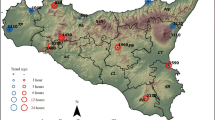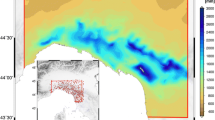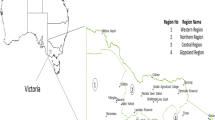Abstract
Intensification of heavy precipitation as discussed in climate change studies has become a public concern, but it has not yet been examined well with observed data, particularly with data at short temporal scale like hourly and sub-hourly data. The original data set was retrieved by using an automated recovery approach. We chose four stations, namely, Vercelli (since 1927), Bra (since 1933), Lombriasco (since 1939) and Pallanza (since 1950) which are located in the northwest of Italy. We assessed trends for durations from 5 min to 12 h in seasonal, annual maxima, and number and magnitude of exceedances of the 95th percentile. Split sample tests have been undertaken to assess differences in quantile estimates derived using a Generalised Pareto distribution fitted to Peaks-Over-Threshold series. The statistical analyses performed include parametric and non-parametric tests. Mostly, we cannot reject the trend stationarity hypothesis. There is no uniform trend on extreme events in the whole area. However, some trends are evident and significant for specific stations and specific indices. Specifically, it is obvious that extreme rainfall events have risen in the last 20 years only for short durations.









Similar content being viewed by others
References
Aryal SK, Bates BC, Campbell ED, Li Y, Palmer MJ, Viney NR (2009) Characterizing and modeling temporal and spatial trends in rainfall extremes. J Hydrometeorol 10(1):241–253
Benjamini Y, Hochberg Y (1995) Controlling the false discovery rate: a practical and powerful approach to multiple testing. J R Stat Soc Ser B 57:289–30
Brunetti M, Buffoni L, Mangianti F, Maugeri M, Nanni T (2004) Temperature, precipitation and extreme events during the last century in Italy. Glob Planet Chang 40:141–149. doi:10.1016/S0921-8181(03)00104-8
Burlando P (1989) Stochastic models for the prediction and simulation of precipitation in time (in Italian), Ph.D. Dissertation, Politecnico di Milano, Milano
IPCC (Intergovernmental Panel on Climate Change) (2012) Managing the Risks of Extreme Events and Disasters to Advance Climate Change Adaptation. Special report of the IPCC. http://ipcc-wg2.gov/SREX/images/uploads/SREX-SPM_FINAL.pdf
Coles S (2001) An introduction to statistical modeling of extreme values. Springer, New York
Fatichi S, Barbosa SM, Caporali E, Silvia ME (2009) Deterministic versus stochastic trends: Detection and challenges. J. Geophys. Res. 114, D18121. DOI: 10.1029/2009JD011960
Frei C, Schär C (2000) Detection probability of trends in rare events: theory and application to heavy precipitation in the alpine region. J Clim 14:1568–1584
Fujibe F, Yamazaki N, Kobayashi K (2006) Long-term changes of heavy precipitation and dry weather in Japan (1901–2004). J Meteorol Soc Jpn 84(6):1033–1046
Groisman PY, Karl TR, Easterling DR, Knight RW, Jamason PF, Hennessy KJ, Suppiah R, Page CM, Wibig J, Fortuniak K, Razuvaev VN, Douglas A, Forland E, Zhai PM (1999) Changes in the probability of heavy precipitation: important indicators of climatic change. Clim Change 42:243–283
Groisman PY, Knight RW, Easterling DR, Karl TR, Hegerl GC, Razuvaev VN (2005) Trends in intense precipitation in the climate record. J Clim 18(9):1326–1350
Hamed KH, Rao AR (1998) A modified Mann-Kendall trend test for autocorrelated data. J Hydrol 204(1–4):182–196
Haylock M, Nicholls N (2000) Trends in extreme rainfall indices for an updated high quality data set for Australia, 1910–1998. Int J Climatol 20:1533–1541. doi:10.1002/1097-0088(20001115)20:13<1533::AID-JOC586>3.0.CO;2-J
Helsel DR, Frans LM (2006) The regional Kendall test for trend: Environmental Science and Technology 40:4066–4073
Hennessy KJ, Suppiah R, Page CM (1999) Australian rainfall changes, 1910–1955. Aust Meteorol Mag 48:1–13
Hosking JRM (1990) L-moments: analysis and estimation of distribution using linear combinations of order statistics. J R Stat Soc Ser B 52:105–124
Hurst HE (1951) Long-term storage capacity of reservoirs. Trans Am Soc Civ Eng 116:770–799
Kanae S, Oki T, Kashida A (2004) Changes in hourly heavy precipitation at Tokyo from 1890 to 1999. J Meteorol Soc Jpn 82:241–247
Karl TR, Knight RW (1998) Secular trends of precipitation amount frequency and intensity in the United States. Bull Am Meteorol Soc 79:231–241
Karl TR, Knight RW, Plummer N (1995) Trends in high-frequency climate variability in the twentieth century. Nature 377:217–220
Kendall MG (1975) Rank correlation methods. Griffin, London
Kwiatkowski D, Phillips PCB, Schmidt P, Shin Y (1992) Testing the null hypothesis of stationarity against the alternative of a unit root. J. Econometrics, 159–178
Lang M, Ouarda T, Bobee B (1999) Towards operational guidelines for over-threshold modelling. J Hydrol 225(3):103–117
Leonardi R, Montefinale T, Malvestuto V, Testa O, Beltrano MC (2006) The automatic digitization of time series recorded on graph paper supports. WMO technical conference on instruments and methods of observation, December 4th 2006 (2006-12-04), pages 1–8, XP002477828
Mann HB (1945) Nonparametric tests against trend. Econometrica 13:245–259
Mathieu, R (2012) POT Generalized Pareto Distribution and Peaks Over Threshold. R package version 1.1-3.http://CRAN.R-project.org/package=POT
Milly PCD, Betancourt J, Falkenmark M, Hirsch RM, Kundzewicz ZW, Lettenmaier DP, Stouffer RJ (2008) Stationarity is dead: whither water management? Sci 319(5863):573–574
Ntegeka V, Willems P (2008) Trends and multidecadal oscillations in rainfall extremes, based on a more than 100-year time series of 10 min rainfall intensities at Uccle. Belgium Water Resour Res 44, W07402. doi:10.1029/2007WR006471
Peterson TC, Zhang X, Brunet-India M, Vazquez-Aguirre JL (2008) Changes in North American extremes derived from daily weather data. J Geophys Res - Atmos 113:DO7113
Phillips PCD, Perron P (1988) Testing for a unit root in time series regression. Biometrika 75:335–346
Pickands J (1975) Statistical inference using extreme order statistics. Ann Stat 3(1):119–131
Saidi H, Ciampittiello M, Dresti C, Ghiglieri G (2012) The climatic characteristic of extreme precipitations for short-term intervals in the watershed of Lake Maggiore. Theor Appl Climatol DOI. doi:10.1007/s00704-012-0768-x
Santos JF, Portela MM, Pulido-Calvo I (2011) Regional frequency analysis of droughts in Portugal. Water Resour Manage 25:3537–3558. doi:10.1007/s11269-011-9869-z
Suppiah R, Hennessy KJ (1998) Trends in total rainfall, heavy rain events and number of dry days in Australia, 1910–1990. Int J Climatol 10:1141–1164. doi:10.1002/(SICI)1097-0088(199808)18:10<1141::AID-JOC286>3.0.CO;2-P
Ventura V, Paciorek CJ, Risbey JS (2004) Controlling the proportion of falsely rejected hypotheses when conducting multiple tests with climatological data. J Clim 17:4343–4356. doi:10.1175/3199.1
Von Storch H (1995) Misuses of statistical analysis in climate research. In: Storch HV, Navarra A (eds) Analysis of climate variability: applications of statistical techniques. Springer, Berlin, pp 11–26
Wu H, Soh LK, Samal A, Chen XH (2008) Trend analysis of streamflow drought events in Nebraska. Water Resour Manage 22:145–164. doi:10.1007/s11269-006-9148-6
Yue S, Wang CY (2004) The Mann-Kendall test modified by effective sample size to detect trend in serially correlated hydrological series. Water Resour Manage 18:201–218
Acknowledgments
This study was carried out as part of the STRADA project funded under the Cross-border Cooperation Programme INTERREG 2007–2013 Italy-Switzerland. We would like to thank prof. Younes Alila (University of British Columbia-Canada) for his insightful comments in this research. We are grateful to the anonymous reviewers whose suggestions allowed us to improve the presentation of our results.
Author information
Authors and Affiliations
Corresponding author
Rights and permissions
About this article
Cite this article
Saidi, H., Ciampittiello, M., Dresti, C. et al. Assessment of Trends in Extreme Precipitation Events: A Case Study in Piedmont (North-West Italy). Water Resour Manage 29, 63–80 (2015). https://doi.org/10.1007/s11269-014-0826-5
Received:
Accepted:
Published:
Issue Date:
DOI: https://doi.org/10.1007/s11269-014-0826-5




